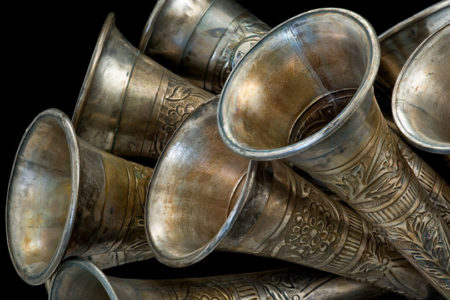Heaven: What Is It Really Like? Revelation 21
Have you ever taken an extended trip? While you may have enjoyed every moment of your adventure, it eventually became tiring. The food was not to your liking, the monotonous miles took their toll physically, and there came a time when you could hardly wait to get home. When you finally arrived there, the bed felt so good, and the house and surroundings were comfortably familiar. You were home at last.
Every child of God is on a pilgrim journey. The road is sometimes rocky and rough, and difficulties come on a regular basis. As the years fly by, you begin to realize why the saints of previous generations all expressed a desire to go home. But what is that home like? Your father may have talked about “streets paved with pure gold,” while your mother said she was going to “heaven.” Others spoke of a place “where Jesus is.” They longed to be free from the burdens, heartaches, problems, and illnesses of this life. But where were they going?
Today, believers in the Lord talk about their future home, but most know little more about it than what was expressed above. To learn more about our eternal home, let’s examine the Scriptures and see what they have to say about the subject.
THE DESTRUCTION OF THE HEAVENS AND THE EARTH
Man does not want to face reality. Death is a major problem to him. He doesn’t want to think about eternity. Hell is no longer a popular subject in the pulpits of America. Funeral homes have “slumber rooms.” In his quest for comfort, man craves only soothing thoughts.
Similarly, many believers do not want to let go of this world. Their lives are wrapped up in the humanistic materialism that pervades the culture of our day. But the Apostle Peter made it clear that everything we now see and know will be destroyed: “But the day of the Lord will come as a thief in the night, in which the heavens shall pass away with a: great noise, and the elements shall melt with fervent heat; the earth also, and the works that are in it, shall be burned up … Nevertheless we, according to his promise, look for new heavens and a new earth, in which dwelleth righteousness” (2 Pet. 3:10, 13).
This inspired writer of old told us that the present earth will not be our final abode. God has something far better planned for us called the “new heavens and a new earth.” This old earth will be restored to its original condition only for the millennial reign of Christ. Our ultimate destination, however, will be brand new.
THE NEW HEAVENS AND THE NEW EARTH
The Prophet Isaiah made the following significant statement: “For, behold, I create new heavens and a new earth, and the former shall not be remembered, nor come into mind” (Isa. 65:17). What we now know as the heavens and the earth will no longer be remembered.
Some of God’s people are so anchored to this world and present life that Isaiah’s statement upsets them. They must understand that our final destination will be wonderful, totally new, created by God for His children only, and there we will be with the Lord forever.
Peter and Isaiah told of the “new heavens and a new earth.” To learn what these places are like, we must examine the last two chapters of the Book of the Revelation.
John said, “And I saw a new heaven and a new earth, for the first heaven and the first earth were passed away, and there was no more sea” (Rev. 21:1). The aged apostle, who was so close to the Lord Jesus, concurred with and verified the statements of Peter and Isaiah, and he added a new dimension. With the words “no more sea,” John clarified that this is not a description of either the first heaven and earth or the millennial earth, which will be completely restructured when the curse is removed and Christ comes to rule. Two-thirds of the present earth is covered by water. It has seas. The millennial earth will also have seas, as seen in Ezekiel 47, which speaks of fishermen, water, and great seas. The new earth must, therefore, be different from the millennial earth.
THE NEW JERUSALEM
John’s attention was then drawn away from the wonderful sights of the new heavens and new earth and was focused on “the holy city, new Jerusalem, coming down from God out of heaven, prepared as a bride adorned for her husband” (Rev. 21:2). John devoted the greater part of the next two chapters to a description of this magnificent sight.
It Will be the Final Home of Believers
Many scholars believe that the new Jerusalem will not appear until the eternal state with its new heavens and new earth. Others contend that the new Jerusalem will be suspended over the earth during Christ’s thousand-year reign and that the saints will have access to the earth from it during that time.
It Will Be the Home of All Believers
John also seems to indicate that the New Jerusalem will be the home of all true believers in Christ, although some question the fact that all believers will be there because of the references to the bride of Christ in verses 2 and 9. However, the analogy of the adornment as a bride is apparently used to point out the beauty and freshness of a bride on her wedding day. Most women are more beautiful on that special day than at any other time in their lives.
Old Testament Saints Looked for a City
Abraham looked “looked for a city which hath foundations, whose builder and maker is God … But now they desire a better country, that is, an heavenly; wherefore, God is not ashamed to be called their God; for he hath prepared for them a city” (Heb. 11:10, 16). The Old Testament saints were looking for a city—the new Jerusalem is that city. Revelation 21:12 states that the names of the 12 tribes of Israel are written on the 12 gates of the city. Why would this be so if the New Jerusalem were not to be the eternal dwelling place of Jewish believers from Old Testament days?
New Testament Saints Will Be There
For over 19 centuries, New Testament believers have clung to Jesus’ promise, “I go to prepare a place for you” (Jn. 14:2). In the same context He spoke of many mansions in His Father’s house. We too look for the city that John saw to be our eternal home.
God Will Dwell With Men There
God has desired to fellowship with man ever since He came to Adam and Eve in the cool of the evening. They must have been wonderful times of close communion together. With the advent of sin into the world, God could no longer directly dwell with men, but His presence was evidenced in other ways. He was in the burning bush when He spoke with Moses. His shekinah glory was with the children of Israel in the wilderness as a pillar of cloud by day and a pillar of fire by night. When the Tabernacle was built, His presence hovered over it, as it did later in the Temple of Solomon. Because of Israel’s subsequent idolatry, however, the glory of God left the Temple and went up from the city of Jerusalem from the Mount of Olives (see Ezek. 8–11).
Almost two thousand years ago, the glory of God came to earth in the person of His Son, but He was rejected by His own brethren, who sent Him to the cross. Shortly after His resurrection, He too left the earth by way of the Mount of Olives.
But in the new Jerusalem, God will finally tabernacle or dwell with men permanently. The Feast of Tabernacles points to this fact: “And I heard a great voice out of heaven saying, Behold, the tabernacle of God is with men, and he will dwell with them, and they shall be his people, and God himself shall be with them, and be their God” (Rev. 21:3); “And there shall be no more curse, but the throne of God and of the Lamb shall be in it, and his servants shall serve him” (Rev. 22:3).
The presence of deity will be with men. That for which God and man have longed will finally become a reality. What fellowship, what rejoicing what pure delight! The problem of sin will be resolved, and the problems of the physical body will be over. God and man will fellowship forever in the new Jerusalem.
Tears Will Be Gone Forever
Since the day man sinned in the Garden of Eden, tears, toil sweat, heartache, wars, pain, the curse of childbirth, and death have been his lot. Life has been difficult. Job said, “man is born unto trouble” (Job 5:7). In the new Jerusalem all trouble will be gone. “And God shall wipe away all tears from their eyes; and there shall be no more death, neither sorrow, nor crying neither shall there be any more pain; for the former things are passed away” (Rev. 21:4).
Those Present in the New Jerusalem
This portion of Scripture mentions two groups of people who will inhabit the new Jerusalem. First, those who are thirsty will be there: “I will give unto him that is athirst of the fountain of the water of life freely” (Rev. 21:6b). This is not a new concept to the reader of Scripture. Isaiah said, “Ho, every one that thirsteth, come to the waters, and he that hath no money; come, buy and eat; yea, come, buy wine and milk without money and without price” (Isa. 55:1). John, consistent with his statement in Revelation 21:6, also stated that Christ offered to the woman at the well “water springing up into everlasting life” (Jn. 4:14).
Second, John wrote that the ones who overcome will receive all things and will be in the new Jerusalem. Who are these overcomers? The apostle said in 1 John 5:4–5, “For whatever is born of God overcometh the world; and this is the victory that overcometh the world, even our faith. Who is he that overcometh the world, but he that believeth that Jesus is the Son of God?”
The conclusion is very basic. Those present in the new Jerusalem will be those who have thirsted and have drunk of the water of life. They are also those who have overcome because they have believed on the Lord Jesus Christ. “And there shall in no way enter into it anything that defileth, neither he that worketh abomination, or maketh a lie, but they who are written in the Lamb’s book of life” (Rev. 21:27).
Those Not Present in the New Jerusalem
“But the fearful, and unbelieving, and the abominable, and murderers, and fornicators, and sorcerers, and idolaters, and all liars, shall have their part in the lake which burneth with fire and brimstone, which is the second death” (Rev. 21:8). Rather than dwelling in the new Jerusalem, unbelievers will be consigned to the “lake of fire” or the “second death” referred to in Revelation 20:14–15.
John’s Description of the New Jerusalem
John saw “the glory of God” in the new Jerusalem, and the sight was so awesome that the only way he could describe it was to equate it with a precious stone that reflects light with all its dazzling beauty (Rev. 21:11). The stone John mentioned is clear, almost transparent, the type that would reflect the glory of God.
The Gates, Walls, and Foundations
John saw 12 gates in the walls of the new Jerusalem (Rev. 21:12), three on each side, each made of one pearl. On each gate was inscribed the name of one of the 12 tribes of Israel. He also saw 12 foundations, each bearing the name of one of the 12 apostles. Each foundation was made of a different type of precious stone. What beauty! What glory there is in the presence of the Lord Himself. From this description, we can conclude that the inhabitants of the new Jerusalem will be saints from all the ages, not just those from the Church age.
The city will be immense in size, larger than any city we have ever known. “And the city lieth foursquare, and the length is as large as the breadth; and he measured the city with the reed, twelve thousand furlongs. The length and the breadth and the height of it are equal” (Rev. 21:16).
Some say the city will be shaped like a pyramid, while others believe it will be in the form of a cube. There are differing views as to the length of a furlong in John’s day, so the estimates of the city’s size range from 1,322.73 miles to 1,500 miles on each side. In any case, the city would cover the entire eastern United States from the Atlantic Ocean to the Mississippi River—and probably more. We can scarcely imagine a city that large. What a glorious home the Lord is preparing for His people.
The Temple in the City
All ancient civilizations built temples. The heathens built magnificent shrines to their multitude of gods. If you visit the land of Israel today, you will see the remains of many heathen temples built both before and during the time of the Jewish habitation of the land. The Jews also wanted a temple, and David wanted to build it, but permission to do so was finally granted to his son, Solomon. Zerubbabel built the Second Temple after the destruction of Solomon’s Temple, and Herod constructed the Temple standing during Jesus’ day. All three were beautiful.
John made one simple statement concerning a temple in the new Jerusalem: “And I saw no temple in it; for the Lord God Almighty and the Lamb are the temple of it” (Rev. 21:22). There will be no structure built with hands. God alone will be worshiped and will be the place of worship.
The Light of the New Jerusalem
On a dark night we long for the rays of the sun. The time just before those rays come into view is the darkest part of the night. Then the sun, in all its brilliance, lights the sky and warms our path. Will God’s city be dark? No, for in Him there is no darkness.
“And the city had no need of the sun, neither of the moon, to shine in it; for the glory of God did light it, and the Lamb is the lamp of it” (Rev. 21:23). Jesus said, “I am the light of the world” (Jn. 8:12). Little did men realize what He meant. For all of eternity He will be our light. There will never be another dark, lonely night. Jesus will be the light of the new Jerusalem.
We Will See Jesus in That City
“And they shall see his face” (Rev. 22:4a). What a time that will be when we can actually look into Jesus’ face—a face we have never seen but which so many artists have valiantly tried to portray. To see the face of the one who gave His life, His all for us at Calvary will be worth all the tears, heartaches, and pain of this life. To see Him face to face “will be glory,” as the hymnwriter said.
Not only will we see Him, but “his name shall be in [our] foreheads” (Rev. 22:4b). This will be a symbol of our identification with Christ. When a bride leaves the church on the arm of her husband after the wedding ceremony, she bears his name. In like manner, the child of God will be identified with Christ throughout all eternity, having His name written upon his forehead.
The Final Invitation to the New Jerusalem
After describing the beauty, glory, and majesty of the new Jerusalem, the Holy Spirit extended one final invitation to join the throng that will stand before the throne in that city. It is an open invitation to any and all who will accept it. “And the Spirit and the bride say, Come. And let him that heareth say, Come. And let him that is athirst come. And whosoever will, let him take the water of life freely” (Rev. 22:17).
Near the end of His written Word, God invites you to “Come.” Will you do so?







